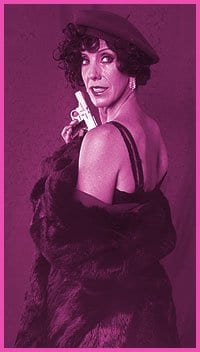Sky Gilbert’s Play Murder is not a homosexual play. Or is it? It is certainly a delightful sex comedy of bad manners and swell intrigue. When a suicidal husband resorts to self-conscious insight regarding his own flaccid member, it all becomes a complex hybrid of queer drama, farce, historical re-enactment and an interrogation of the ways in which theatre has tended to depict romance from the beginning of stage time.
Focussing on 1930s torch singer Libby Holman’s marriage to tobacco heir Smith Reynolds, the text toys with the premise, What really happened the night when? Gilbert speculates upon unknown details within the lives of historical figures and creates an entertaining study of representation. When we see two men or women bonding on stage, street or screen, and become curious as to what may or may not have been hinted at and/or left out, we are responding to homosocial encounters. Play Murder is all about the homosocial – as it flirts with the homosexual.
Ann Holloway as actress Blanche Yurka is fabulous, and delivers some of the most memorable lines. When, following an extended meditation on a speech from A Streetcar Named Desire, she wistfully contemplates, “The back of Tennessee Williams’ mind,” the audience explodes with laughter. Ellen Rae Hennessy, as Libby, is a study in exquisite timing and comic physicality. Edward Roy’s Slick leads the interrogation scenes with impeccable, quirky characterization. Jason Cadieux’s Smith Reynolds is a fine enactment of straight male angst coming up against his wife’s ambition, not to mention her lesbian companion, Louisa, played with butch, debonair reserve by the elegantly coiffed Jane Johanson.
Cadieux’s turn at playing a simpering puppy on all fours is cute in the extreme and should not be missed by anyone delighted by the sight of a beautiful male actor in a compromising position. Marc Gushuliak’s Ab, Smith’s best friend, impresses in a period bathing suit as he handsomely plays the altruistic “swimming” buddy with a great deal of credibility, abdominal energy and pectoral grace.
Steve Lucas’ naturalistic setting is impressive, but falls short due to limited entrances and exits rendering some of the levels superfluous. Gilbert, who also directs, has used the platforms and stairways well in order to create an action-packed evening, but his set notes in the published text might have been adhered more closely in order to better serve a very stylized script. Jeff Logue’s lighting articulates distinct areas but is often overwhelmed by the set – a reminder that less can be more.
John Alcorn’s music and Wendy White’s period costumes add finishing touches to a provocative piece of theatre.
But is this a homosexual play? It is certainly a very sexual play that flirts with murder, homosociality, lesbianism and the idea that we can never fully understand a single life, a single sexuality, a single narrative – or even a single evening in the theatre.
Part of Gilbert’s dramaturgical project over the years has been to include postmodern elements in his work. Actors stepping out of character and addressing the audience, lip synched dance numbers that suddenly appear out of nowhere and brief self-referential monologues that describe gender roles, misogyny and homophobia, are welcome and essential components of a body of work that continues to challenge conventional notions of what theatre – and life – can be.
Play Murder includes all of these elements, so it may be confusing for a mainstream audience. And yet, as Buddies In Bad Times enters its 25th year of queer theatre, it seems fitting that the season opener defies the reality of much of this city’s commercial theatre.
Play Murder poses provocative questions about sex and gender, leaving the audience to grapple restlessly with answers that rarely lead to solutions. But isn’t that the mystery, and the mastery, of art and of love?
* Play Murder continues at Buddies In Bad Times Theatre (12 Alexander St) until Sun, Oct 12; call (416) 975-8555.

 Why you can trust Xtra
Why you can trust Xtra


